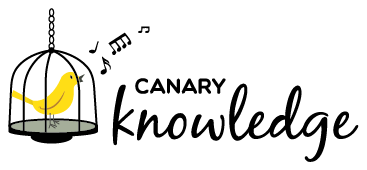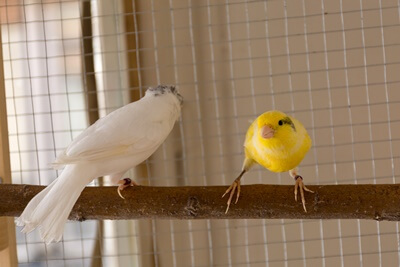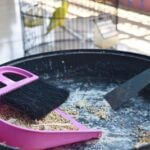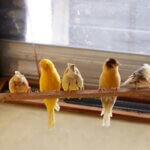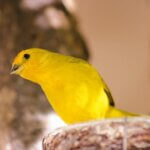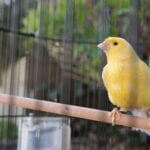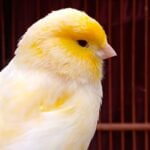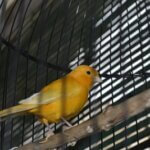Last Updated on: 22nd October 2022, 08:45 pm
If your canary chokes or makes a gagging sound that might be choking, it’s natural to be concerned.
After all, you can’t perform the Heimlich maneuver on a bird. Also, its mouth is too small for you to reach in and dislodge whatever is blocking its airways.
However, there are ways to help your canary when choking.
Can A Canary Choke On Food?
Choking is often caused by hard, oversized, or partially broken-down food lodged in the throat. Canaries are small birds, so debris or food particles don’t need to be large to cause a blockage.
Choking is a medical emergency caused by obstruction of the airways due to damage, inflammation, or the presence of foreign objects in the trachea.
All animals are susceptible to choking, even though birds swallow whole food rather than chewing to grind it down.
Choking can be rectified if the airway is cleared, but it can be hard to dislodge a foreign body without assistance. If the airway remains blocked, the outcome of choking will be death.
Other common reasons for choking include:
- Swelling due to injury
- Allergic reaction
- Crushed or constricted trachea
- Ingestion of small, inedible objects
Whatever the cause, choking is different from aspiration.
Aspiration vs. Choking in Canaries
Aspiration has the same overall result as choking, but the process differs.
While choking is a restriction or blockage in the airway or trachea, aspiration occurs when foreign objects, food, or liquids are breathed into the lungs.
Aspiration can be fatal when left untreated, but there can be long-lasting repercussions even when it’s addressed. According to the Journal of Exotic Pet Medicine, canaries are susceptible to respiratory issues, and the damage caused by aspiration can exacerbate non-infectious and infectious disorders.
The main risk associated with aspiration is lung damage or secondary drowning because the liquid was inhaled. Meanwhile, choking is more likely to cause or damage the trachea.
Despite the uniqueness of each, there are common risk factors that’ll cause or increase the chances of aspiration and choking in canaries, including:
- Weak throat and jaw muscles
- Eating too quickly
- Eating too much at once
- Difficulty swallowing (dysphagia)
- Acid reflux/GERD
- Inflammation of the throat
Suppose your canary has any pre-existing injuries or conditions that weaken the lungs, trachea, larynx, or neck or cause vomiting or acid reflux. In that case, the risk of choking and aspiration increases.
Why Is My Canary Gagging?
If your canary seems to be gagging or retching, that doesn’t automatically mean it’s aspirating or choking. While they can make it seem like a canary is gagging, it may be trying to regurgitate or vomit.
This is a natural behavior for nesting birds taking care of their young. However, it can also be caused by digestive issues and illnesses.
Alternatively, a canary might seem to gag if it’s having trouble swallowing due to inflammation or injury to its throat. This is more likely if the throat has already been damaged by choking.
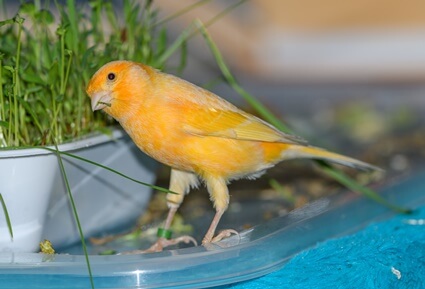
How To Know If A Canary Is Choking
The signs of choking in canaries can vary, and they may be subtle. However, you can spot them if you know what to look for. The common symptoms of choking are as follows:
- Difficulty breathing
- Gagging or retching
- Extending the neck
- Opening the beak excessively wide
- Gasping or coughing (very quiet)
These symptoms may tie over with aspiration. Nonetheless, aspiration is often more subtle because small amounts of liquid in the lungs may not cause the same dramatic discomfort as choking does at first.
A canary that has inhaled some water or liquid from food may gasp, cough, or show signs of choking at first and then calm down. Long-to-mid-term symptoms of aspiration include:
- Labored breathing
- Rapid or shallow breathing
- Lethargy
- Coughing or sneezing
- Fluffing up
- Lack of appetite
You should seek veterinary care if these last symptoms after a short choking event.
Aspiration and aspiration pneumonia are life-threatening conditions for a canary, but especially for ones with underlying health issues or vulnerabilities.
How Do You Help A Choking Canary?
If you witness signs that your canary is choking, remain calm. Clear, decisive action will help resolve a serious case of choking quickly (and with the least amount of damage to your canary).
In minor, harmless cases of choking, clear-headedness will allow you to watch for other signs and make the best decision for your pet canary.
Of course, it’s natural to panic and become upset, but this won’t help your canary. Your emotional distress should be saved until after your canary is breathing easily again.
1/ Give It Some Time
Allow your canary a few seconds to try to clear its airway alone. Although this may seem counterintuitive, being handled while choking may cause the bird to panic.
Then, it might continue to choke or accidentally swallow whatever blockage it has further, damaging its throat without dislodging the problem.
Wait 4-6 seconds and keenly observe how your canary is behaving. Does it grow more distressed, or is it calming down? Is it wheezing and gasping, or are its vocalizations returning to normal?
If it appears the canary is handling the problem by itself, continue watching it until you’re sure it’s okay.
2/ Calmly Lift The Canary
You should intervene if your canary hasn’t dislodged the food or foreign object after 4-6 seconds. Speak calmly to your canary and lift it in your hands; apply firm but gentle pressure, and don’t restrain its head.
3/ Turn It Upside Down
Once you have your canary in hand, carefully turn it upside down. Gravity may be enough to help your canary dislodge this blockage.
If it continues to struggle after a second, apply gentle pressure to the keel (or breastbone) and rub it. This can stimulate the airway enough to dislodge the item.
4/ Bob Its Head
You can also help your canary stimulate regurgitation. Hold the beak (don’t close it) and bob the head like canaries do when regurgitating food.
Doing this will activate the muscles and often trigger the ejection of the food or object.
5/ Emergency Advice
If this doesn’t work, contact your vet’s emergency number. You can place the phone on speakerphone while using these stimulation methods.
6/ Physically Dislodge It
A more invasive measure your vet might suggest is to look into the canary’s mouth to see if the blockage is visible. If it is, you may be able to use a small cotton bud or similar object to dislodge it by hand.
You should only do this if nothing else works and you’re certain you can’t reach your vet in time.
Having the vet on the phone to guide you through the process (and any complications) is recommended. If done incorrectly, this could harm your canary more than help them.
7/ Check-Up
Once a blockage is removed, you should take your canary to the vet, especially if the choking is severe and prolonged and there may have been aspiration or damage to the throat.
Your vet will help you to prevent secondary infections and issues by examining the canary and providing a treatment plan if needed.
Can I Perform The Heimlich Maneuver On A Canary?
Never attempt to use the Heimlich maneuver on a choking canary (or any bird).
Not only is this an ineffective option, but it could also hurt your pet canary. Avian species like canaries don’t have a diaphragm, and this body part is required for the Heimlich maneuver.
The diaphragm is a large muscle positioned just below the lungs. Instrumental in breathing, it’s agitated by the Heimlich maneuver to produce a powerfully explosive cough, much stronger than an animal or person can produce alone. This force is used to dislodge stuck food or foreign objects.
As birds lack this muscle, there’s nothing to agitate. Applying hard pressure on their abdomen or chest may cause injury.
Massaging the keel bone is the closest equivalent that’ll work for a canary. This should be done gently, and it can stimulate the airway to aid your canary in dislodging the food or object stuck in its trachea.
How To Prevent Choking In A Canary
To reduce choking risks, provide food designed for canaries at regular intervals.
This will ensure the canary isn’t forced to swallow larger-than-normal portions of food, reducing the likelihood of one eating too quickly due to feelings of food insecurity.
Beyond this, try to avoid fragile plastic toys that could crack or shatter and, thus, drop small sharp pieces of plastic your canary may swallow.
Instead, offer durable toys made of shatter-proof or natural materials. Even with these better toys, remove any that show damage or cracking.
If your canary has several choking incidents in a short period, ask your vet to check for medical issues. For example, choking becomes more likely if your canary has digestive issues or damage to its throat.
Furthermore, some underlying medical conditions can weaken the jaw and throat muscles, drastically increasing the chances of choking and may result in your canary needing specialist food.
